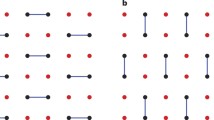Abstract
A recent proposal to solve the halting problem with the quantum adiabatic algorithm is criticized and found wanting. Contrary to other physical hypercomputers, where one believes that a physical process “computes” a (recursive-theoretic) non-computable function simply because one believes the physical theory that presumably governs or describes such process, believing the theory (i.e., quantum mechanics) in the case of the quantum adiabatic “hypercomputer” is tantamount to acknowledging that the hypercomputer cannot perform its task.
Similar content being viewed by others
References
Copeland, J. (2002), ‘Hypercomputation’, Minds and Machines 12, pp. 461–502
Davis, M. (2003), ‘The Myth of Hypercomputation’, in C. Teuscher, ed., Alan Turing, Life and Legacy of a Great Thinker, New York: Springer
Farhi, E. et al. (2000), Quantum Computation by Adiabatic Evolution, Archive Preprint quant-ph/0001106
Hodges, A. (2005), ‘Can Quantum Computing Solve Classically Unsolvable Problems?’, Archive Preprint http://arxiv.org/quant-ph/0512248
Hogarth, M. (1994), ‘Non-Turing Computers and Non-Turing Computability’, PSA 94(1), pp. 126–138
Kieu, T.D. (2002), ‘Quantum Hypercomputability’, Minds and Machines 12, pp. 541–561
Kieu, T.D. (2003), ‘Computing the Noncomputable’, Contemporary Physics 44, pp. 51–71
Kieu, T.D. (2004), ‘A Reformulation of Hilbert’s Tenth Problem through Quantum Mechanics’, Proceedings of the Royal Society A 460, pp. 1535–1545
Kieu, T.D. (2005), ‘An Anatomy of a Quantum Adiabatic Algorithm that Transcends the Turing Computability’, International Journal of Quantum Information 3(1), pp. 177–183
Lloyd, S. (1995), ‘Quantum Mechanical Computers’, Scientific American 95(10), pp. 44–50
Messiah, A. (1961), Quantum Mechanics Volume II, New York: Interscience Publishers
Moore, C. (1990), ‘Unpredictability and Undecidability in Dynamical Systems’, Physical Review Letters 64, pp. 2354–2357
Pitowsky, I. (1990), ‘The Physical Church Thesis and Physical Computational Complexity’, Iyyun 39, pp. 81-99
Pitowsky, I. and Shagrir, O. (2003), ‘Physical Hypercomputation and the Church-Turing Thesis’, Minds and Machines 13, pp. 87-101
Pour-el, M. and Richards, I. (1981), ‘The Wave Equation with Computable Initial Data such that Its Unique Solution is not Computable’, Advances in Mathematics 39, pp. 215–239
Reichardt, B.W. (2004), ‘The Quantum Adiabatic Optimization Algorithm and Local Minima’, Proceedings of the 36th Symposium on Theory of Computing (STOC), pp. 502–510
Smith, W. (2005), ‘Three Counterexamples Refuting Kieu’s Plan for “Quantum Adiabatic Hypercomputation”; and Some Uncomputable Quantum Mechanical Tasks’, Forthcoming
Author information
Authors and Affiliations
Corresponding author
Rights and permissions
About this article
Cite this article
Hagar, A., Korolev, A. Quantum Hypercomputability?. Mind Mach 16, 87–93 (2006). https://doi.org/10.1007/s11023-005-9006-y
Received:
Accepted:
Published:
Issue Date:
DOI: https://doi.org/10.1007/s11023-005-9006-y




